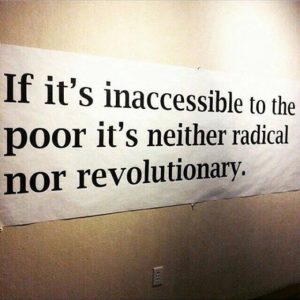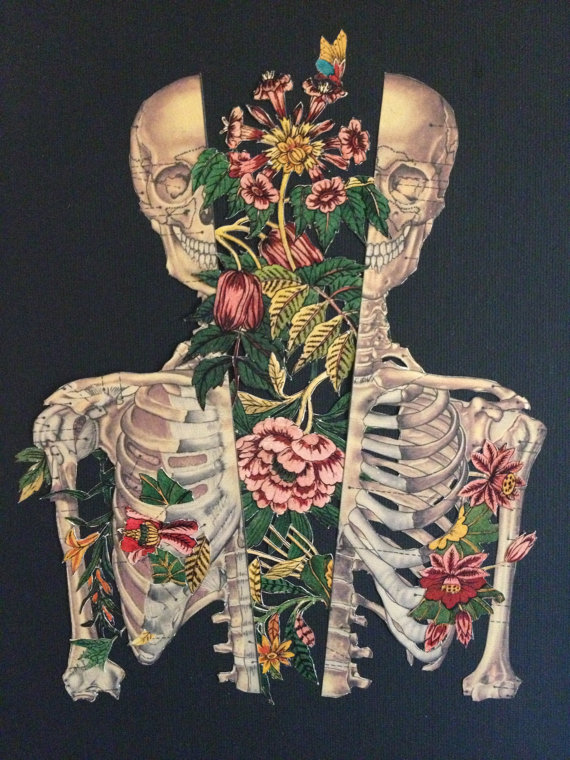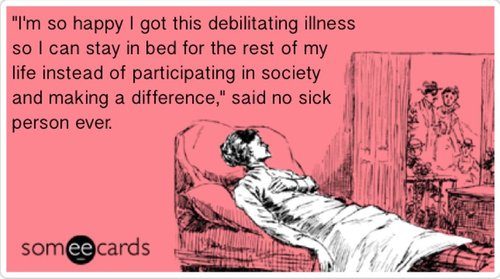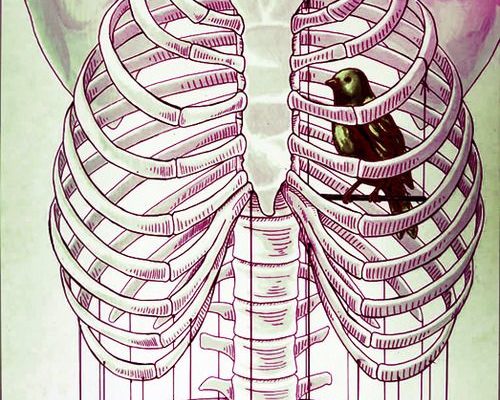This blog was originally hosted at Empty Cages Design.org as part of a series on Overcoming Burnout from 2016-2017. It has now been turned into a book that is available at: https://solidarityapothecary.org/overcomingburnout/
This piece is about my ‘physical’ journey to recovering from burning out. For me, my burnout manifested in a chronic illness that has knocked me sideways, reduced my activity and created space in my life for reflection and transformation. It has also caused me months of pain, distress, and despair. But finally, the last two months have seen a fast healing curve where my energy, strength, and resilience seem to be returning, albeit at a very gentle pace.
In this blog I want to share a bit of background about costochondritis, to build awareness of this condition and its effects. I will share the herbs, nutrition, physical therapies and other sources of relief that I have experimented with in the 8 months of nursing the chronically inflamed cartilage in my rib cage. I want to emphasise that I am not a health professional. Please do not substitute this blog for speaking to someone who has invested energy and time in learning about the complexities of health, like a doctor.
Likewise, I have introduced many of these different interventions slowly over time. Different things were needed at different points. It is impossible for me to say what can help heal other people’s costochondritis or chronic health issues, therefore this post is literally for interest only. I want to illuminate the complexity of attempting to heal from a chronic illness and how focusing on nourishing myself as a whole person, rather than fighting some evil, invading, punishing disease, has supported my return to health.
What is Costochondritis?
Costochondritis is an inflammation of the cartilage that connects a rib to the breastbone (sternum). Pain caused by costochondritis might mimic that of a heart attack or other heart conditions. Costochondritis is sometimes known as chest wall pain, costosternal syndrome or costosternal chondrodynia. Sometimes, swelling accompanies the pain (Tietze syndrome) [1].
There is unclear evidence about what causes costochondritis. Observed potential causes include injury, physical strain (e.g. coughing), a joint infection, tumour or some kind of other inflammatory condition such as arthritis. There is a good list online that lists things that produce similar pain. I found I had to basically work through this list and get different things ruled out (like blood clots, cancers, pneumonia, fractures etc.). Hence why I cannot stress enough to see your doctor and access those diagnostic tools.
The NHS page describes how costochondritis normally goes away after a couple of weeks. I’ve found so many people on forums, social media and in person that have experienced costochondritis for several months or more. Obviously, we are all unique, with so many complex factors at play in our recovery.
How does it feel
The pain definitely changes, but overwhelmingly these have been some of the daily experiences:
- Like someone is stabbing me with a knife at various points in my chest at different times of day
- That some wild animal is eating the flesh off my ribs and gnawing on the bones
- That a bag of hot needles is being scraped across my chest
- That a grown man is sitting on my chest all the time
- That a tight hot band is running around my chest and getting tighter as the day goes on
- That something is trying to tear my ribs apart
- That I can’t breathe. Or when I take a deep breath I get stabbed.
- That I can’t get comfortable in any position because the pain is all over my front, sides and back
- That my joints are aching, my whole body is fatigued and all vitality is gone simply fighting the pain
Things I’ve done so far…
Accessing Support
 My incredible 94-year-old Grandad at the start of this distressing period offered to pay for treatments I needed because he loved and cared about me and just wanted me to be well. It was hard for me to simply accept his support without guilt, however, without his help, I have no idea what state I would be in right now. I am very aware that private therapies are completely financially inaccessible for folks on low incomes. This has been a recurrent theme at the Radical Herbalism Gathering, which does list many herbalists that offer sliding scale clinics. I think if my Grandad wouldn’t have been able to help I would have taken out a loan or something from a credit union. Anyhow, all it does to is emphasise to me the desperate need for us to radically transform our health systems.
My incredible 94-year-old Grandad at the start of this distressing period offered to pay for treatments I needed because he loved and cared about me and just wanted me to be well. It was hard for me to simply accept his support without guilt, however, without his help, I have no idea what state I would be in right now. I am very aware that private therapies are completely financially inaccessible for folks on low incomes. This has been a recurrent theme at the Radical Herbalism Gathering, which does list many herbalists that offer sliding scale clinics. I think if my Grandad wouldn’t have been able to help I would have taken out a loan or something from a credit union. Anyhow, all it does to is emphasise to me the desperate need for us to radically transform our health systems.
I really believe in DIY healthcare and self-educating. However, I also believe that we all need to access support (of course these two things are definitely not mutually exclusive). I am very aware of the power dynamics at play. However, health professionals (who I would see as someone passionately engaged in their field) have this pattern-level view of what is happening. Trust me, when experiencing a chronic illness you need all the support you can get. I cannot recommend seeking help soon enough. Over several months, I met with different professionals (with varying experiences):
- GP/NHS – Recommended rest and painkillers. Most specifically non-steroidal anti-inflammatories. I was so desperate I took all the pain relief they could throw at me. Unfortunately, this eroded my stomach lining and led to more inflammation connected to my digestion. The painkillers also affected my mental health and ‘depressed’ my system. Most of my interactions with doctors and consultants were incredibly disempowering and left me feeling dejected and despairing. However interacting with the NHS was essential in accessing their diagnostic tools and ruling out things like bone cancer, blood clots, and heart conditions.
- Herbalist – I worked with a local herbalist and nutritional therapist based in Glastonbury. He has been a total rock and his advice and knowledge have been pivotal to my recovery.
- Acupuncture – I sought help from a local acupuncturist. Over the course of several months, she worked magic with her needles on several different aspects of my health, including addressing many blockages in my energy. Most notably, I found the treatments super toning for my digestion, which was a key part of addressing the inflammatory response.
- Chiropractor treatment – I had two treatments that really helped me realise how my body was responding to the pain and how this was affecting my alignment.
- Sports therapist – I have had several treatments with a sports therapist who is an incredible professional dedicated to his field. He used both low-level laser therapy on my chest as well as myofascial release massage. He writes about myofascial release: “Its main focus of treatment is on the bodies vast expansive fascial network. The bodies fascia is an all encompassing connective tissue that surrounds, infuses, supports and constrains every muscle and organ in the body. Its continuity and endlessness means that the effect of its restriction can cause imbalance in the joints of the body which, in turn, causes an imbalance on posture. This compromises the body’s ability to function at its optimum efficiency and strength” [2]. I can safely say his treatments have been an overwhelming contributing factor to healing, reducing pain and regaining movement in my body. My mum even burst into tears after the first treatment with relief!
- Counseling – I am incredibly lucky to live near a low-cost counseling agency that is committed to accessibility. Working with a counselor, I feel I have been addressing the underlying emotional “stuff” that contributed to my condition such as unprocessed grief and trauma. Counseling has been like a ‘weight off my chest’ which has made a huge difference to my wellbeing.
- Yoga – I was super lucky to be supported by a friend who is an experienced yoga teacher. She introduced me to some ‘Restorative Yoga’ positions. She describes how “the slower pace and deep breathing that you get in a restorative yoga class triggers the parasympathetic nervous system from the very first pose. This activation helps to mitigate the effects of the regular fight-or-flight stress response that can be damaging to your physiology and well-being. The overall calming effect on the nervous system sets a deeply relaxing tone for the class that comforts your mind and body down to the cellular level” [3]. I have found this incredibly useful, if not essential, to my healing process.
Herbs
Once again, I want to emphasise that I took all these herbs at different points and stages. Please don’t read this list and think, yeah I’ll try all that stuff! Also be sure to research contraindications because many of these herbs are not suitable for people who are pregnant or on certain medications.
Pain Relief
- I made a pain tonic tincture with a mix of Cramp Bark (Viburnum opulus), St John’s wort (Hypericum perforatum), Valerian (Valeriana officinalis) and Betony (Stachys officinalis). I took a capful in water when the pain was really intense and it always did the trick.
- Willow! Ah, my favourite tree in the world. I took capsules of White Willow Bark (Salix alba) for ease of use and because I didn’t want to go over the top on alcohol based tinctures. Its pain relieving action is actually due more to its effect on inflammation than its quantities of salicylic acid.
Nervous System Support
- I made a nerve tonic tincture – Vervain (Verbena officinalis), Rose (Rosa spp.), and Betony (Stachys officinalis). This triage of herbs have been a powerful support and I intend to blog about them more fully when I look at herbs for burnout.
- I have more recently been using Rosewater as an alternative to my strong rose tincture. I have about 4-5ml in a small glass of water three times a day. Rose is a beautiful herb for grief, insomnia, and depression and is also a known anti-viral.
- I have also used Valerian when I’ve had disturbed sleep patterns because of the pain. I find it gives me quite intense dreams and has a kind of cold, dampening effect, so don’t try to use it too often. However, it is such an amazing plant!
- Passionflower tincture (Passiflora incarnata) has supported me in times of anxiety and stress, I take a few drops often before sleeping.
Adrenal System Support
The ability for me to recover from costochondritis is massively linked to being able to nourish my adrenal system. Herbalist Mathew Wood, in his incredible document about herbs for the musculoskeletal system writes how muscle growth and strength is regulated by hormones and that there is a constant flux between the joint regenerative hormones and cortisol [4].
I have two cups of Licorice tea (Glycyrrhiza glabra) a day (not in the evenings). Licorice has been a long term plant friend of mine that saved me from burnout many times. It also tastes sweet and delicious!
Once my viral and bacterial infections were cleared up and I could focus solely on healing the costochondritis and recovering from adrenal fatigue, I worked with my herbalist to experiment with different adaptogenic herbs. I’d recommend ordering ‘Adaptogens: Herbs of Strength, stamina and stress relief’ by David Winston and Steven Maine if you are interested in these plants. The herbs that I have been using, all in tincture form, at different stages in my recovery include Ashwagandha root (Withania somnifera), Rhodiola rosea, and Astragalus (Astragalus membranaceus). This week I also started using Siberian Ginseng (Eleutherococcus senticosus) after evaluating my progress with my herbalist.
I also take a longstanding hormonal tonic for when I have bad PMT. It is a tincture mix of Lady’s mantle (Alchemilla vulgaris), Evening primrose (Oenothera biennis), and Borage (Borago officinalis).
Anti-inflammatory Herbs
- Turmeric (Curcuma longa) – My kind friend ordered me some amazing turmeric capsules (with black pepper and other ingredients to help increase its effectiveness) from Baldwins. These have been a mainstay amazing anti-inflammatory for me! At the beginning of my bed-bound inflamed state, I would also make a decoction of turmeric and ginger. Please note these herbs can be very warming, best to get advice before taking if you have a ‘hot’ condition.
- I made an anti-inflammatory tincture mix at the beginning of my recovery once I had my diagnosis. These included Chamomile (Matricaria recutita), Self-heal (Prunella vulgaris), Yarrow (Achillea millefolium), Feverfew (Tanacetum parthenium) and Nettle root (Urtica dioica).
Herbs for Cartilage
- I took Devil’s Claw tablets as advised by my herbalist. I used Nature’s Aid ‘Joint Eeze’. I later learned that it is an endangered plant, so will not use it again.
- I made decoctions of Horsetail (Equisetum arvense), for its high silica content.
Topical Applications
There were also a number of herbs and oils that I applied directly on the skin of my chest to bring pain relief and support with healing; these included:
- Ibuprofen Gel – when I was really desperate. It was very cooling and definitely did bring pain relief.
- Arnica Gel – I bought this originally when I sprained my shoulders falling down the stairs (yes this totally happened mid recovery!). I then put it on my chest and realised it served the same cooling action.
- Joint and Muscle Rub – a mixture of comfrey, arnica, wintergreen, and ginger. Seriously, it was heavenly and helped so much.
- Coconut oil with essential oils – So each night before bed I would rub coconut oil on my chest (sometimes almond oil as it feels more warming) with lavender and thyme essential oils (only a drop). The thyme was great in helping shift the lingering respiratory infection.
- MSM and Silica Gel – I found this amazing gel that helps you to absorb MSM (Methylsulfonylmethane) and silica which are essential for cartilage repair. It was from France, however, a friend that could actually speak French read the ingredients and it wasn’t vegan.
- Comfrey Poultices – Once the weather warmed up I began to do comfrey poultices on my chest. This was after several days of doing them on my shoulder after my fall. It was definitely after this period that I noticed a marked change in my pain levels.
- KT tape – I also had myself taped up by a sports therapist, which brought some relief to my tissues. I found that I craved putting the oils on, so in the end, I prioritised them. The tape was great if I had to do more physical movement (like be at an event where I can’t just sit there and rub my boobs for pain relief!).
- Castor oil packs – This involved applying castor oil with muslin and then applying a hot water bottle. Absolutely incredible relief.
Anti-Virals, Anti-Bacterials, and other Immune System Support
When you are trying to recover from a chronic illness and unrelenting exhaustion you are going to be so susceptible to a multitude of viruses, bacteria, fungal infections and parasites. I have certainly found this. It’s felt like every other week I had some weird allergic feeling reaction, or nausea, or some wild temperature changes responding to a virus (NB – I later learnt these were responses to unidentified food intolerances, notably yeast and wheat). However, to buffer these and strengthen my immune system at different points I have used the following herbs:
- Elder (Sambucus nigra) – My initial viral infection that I couldn’t kick even after two months was finally knocked on the head with six weeks of taking Elderberry tincture. I have since used Elderberry ‘syrup’ (a sugar-free version) to contend with more minor viral and post-viral exposure.
- Garlic (Allium sativum) – see the supplements section. Garlic is a wonder plant and I’ve tried to integrate it into my diet as much as possible. It is a fierce anti-bacterial.
- Echinacea Root Tincture (Echinacea spp.) – Oh Echinacea, so commodified yet such a valuable, amazing plant. It’s helped me overcome multiple infections when I’ve needed it and given immune system support.
- Thyme tea (Thymus vulgaris) – Fresh thyme in hot water really helped me to clear my initial bacterial infection and recover from living in a damp room for a long time.
- Yarrow (Achillea millefolium) – is very strengthening when contending with a fever, amongst its other amazing actions.
Liver Support
Liver pains have felt a semi-regular occurrence when processing all the nasty painkillers and dealing with the emotional stress of having your life turned upside down. This organ is just so essential to healing on every level. Inflammation indicates the oxidation and elimination of morbid or pathogenic material, hence why the liver is such an important organ in addressing chronic inflammation. A congested liver can also be a factor in pre-menstrual challenges. I have often needed to nourish my liver with:
- Liver tonic – I made a tincture based liver tonic with Dandelion Root (Taraxacum officinale) and Yellow Dock Root (Rumex Crispus).
- Milk Thistle extract (Silybum marianum) – shop-bought but such a powerful aid that would settle down liver pain in a number of hours.
- Dandelion leaf – Adding a few dandelion leaves to green smoothies is definitely fast access to nutrients.
(Please note if you experience liver pain you really, really need to see a doctor ASAP!).
Supplements
Magnesium – Oh magnesium, it seems I am forever deficient in you! In this period, I have learned how linked magnesium deficiency is to pain and depression. To address these deficiencies I have been:
- Taking magnesium citrate
- Taking magnesium malate
- Using magnesium spray
- Having epsom salts baths (my favourite)
- Silica – Silica is essential for cartilage repair. Like completely, utterly essential. I ordered VitaSil Organic Silicium bio-activated Liquid 500ml online and once again, found myself on an upward curve after its consumption.
- Iron – I have been using Floradix as a way to increase my iron intake, in addition to improvements in my diet.
- B Vitamins – These are super useful for almost every area of health in their support for cellular energy production.
- Vitamin C – I didn’t think I could be deficient in this but for sure, I was. It’s useful for so many functions of the body and more important than ever when you’re trying to support yourself to recover without constantly being knocked back by infections, viruses etc.
- Vitamin D3 – My winter travels and winter stress combined with soggy old England definitely rinsed me of all my vitamin D reserves. Vitamin D is essential for bone repair.
- Kyolic garlic – When I was super ill, an evening faffing around cutting up garlic felt like an effort, so I started taking these supplements to help address fungal infections.
- Vitamin A – Vitamin A is essential for many reasons, including your neural functions and immune system (note that there are risks with having too much – as always, talk to someone before taking things).
- Vitamin B12 – I have been vegan 17 years and only started supplementing with B12 six years ago. Seriously, vegan friends, it is completely essential.
- Probiotics – With so much inflammation linked to the gut, it was clear to me I had to nourish all the little things in there. While touring and desperate I’d taken antibiotics and thus knocked out all the necessary bacteria I need to stay well. Supplementing daily with probiotics gave me a bit more resilience.
- Chromium – I used Viridian GFT chromium complex. Chromium is an essential trace mineral useful for muscle repair amongst other things.
- Glucosamine – I bought Glucosamine HCL vegetarian formula from Higher Nature online because of it being recommended for maintaining healthy joint cartilage. Likewise, it is super difficult to get this as a vegan.
- Higher Nature Thyroid Support Formula with iodine and selenium – At the beginning of the year my thyroid was not functioning well and this supplement was recommended to me to address it.
- Sea Kelp – Likewise, to support my thyroid, sea kelp is a natural source of iodine. I can’t help but really not like the taste of seaweed so supplementing felt like the best option.
- Calcium, magnesium and zinc powder (Viridian) – Calcium, magnesium, and zinc are all necessary for muscle and connective tissue repair.
- MSM powder – MSM (methylsulfonylmethane) has been identified in research to be an important building block of healthy bones and joints, reducing joint pain and swelling.
- Serrapeptase – Is a proteolytic enzyme (an enzyme that breaks down protein) – you can get vegan supplements. It helps to reduce inflammation and pain.
Nutrition
I ordered an e-book called Natural Anti-Inflammatory Remedies by Carmen Reeves. The author describes how any illness or discomfort caused by the presence of bacteria, viruses, fungi, parasites and other pesky pathogens can lead to the inflammatory response.
They recommend these foods to avoid:
- Animal products (Please note it is well known that certain animal proteins will aid gut repair faster, however, it is not impossible to rebuild your gut lining or your resilience with a vegan diet, it just takes more planning and intelligence).
- Corn syrup and high fructose corn syrup
- Processed food
- Fried foods
- Gluten products esp. processed baked goods
- Bad fats
- Refined sugars
They emphasised these foods:
- Foods high in omega 3 fatty acids – such as flaxseed, walnuts, almonds, olives, coconut products and nuts.
- Foods high in antioxidants – such as green kale, broccoli, purple potatoes, cabbage, blueberries, raspberries, cherries, red/black/pinto beans, apples, dark chocolate.
- Foods high in fibre including legumes, fruits, root veg and greens. Plus grains such as quinoa, amaranth, sorghum and buckwheat.
- Key anti-inflammatory foods – including plants from the brassica family – kales, cabbage, radishes, turnips, mustard greens, cauliflower as well as alliums – leeks, garlic, onions, chives etc.
- Anti-inflammatory herbs including cloves, ginger, rosemary, turmeric, black pepper, chamomile, cardamom, coriander, basil, cinnamon, garlic, fennel, parsley and nutmeg.
Other key foods include:
- Soya lecithin – Phosphatidyl choline from lecithin nourishes the nerve endings (myelin) and also supports the liver/gallbladder. I added soya lecithin to smoothies.
- Flaxseed Oil – I took this very intensively at the start, to support with my omega 3 deficiency ( which has been proved to be linked to inflammatory processes). It needs to be cold pressed and kept in the fridge.
NB – many months after this blog was written, I had some blood tests (IgE) for food intolerances. While there are many criticisms of these tests, and many false results are reported, it helped me massively to identify the actual food intolerance triggers of my rib pain. Militantly cutting out wheat and yeast stopped 95% of my flare ups, and looking back I realised many bad episodes were after eating certain foods containing these ingredients which I would have never considered (like fermented foods or even soya sauce). This whole period has inspired me to study herbal medicine at a clinical level, as so much of my pain could have been prevented with certain protocols.
Last Words
My other advice is checking your environment is not mouldy or damp. This can obviously lead to chronic respiratory and other fungal infections. I know what it is like growing up in shit houses with damp rooms and abusive landlords. All I can recommend is getting in touch with local housing groups or Solidarity Networks to confront these landlords collectively!
And finally, don’t laugh but my friends would call me out if I didn’t include this. Sex seemed to be the best therapy. Not at the start, when the pain was so intense I could barely move, but slowly as the months passed and pain decreased, letting a bit of love into my life definitely seemed to be the most healing thing of all. A mixture of releasing tension, stretching and all those feel good hormones have definitely triggered a healing response. Oh, and feeling loved and supported – friends and lovers being the best therapy of all.
References
1. https://www.mayoclinic.org/diseases-conditions/costochondritis/symptoms-causes/syc-20371175
2. http://www.bodyinmotionrehab.co.uk
3. https://www.nesbearyoga.com
4. Herbal Treatment for the Muscular and Skeletal System, Matthew Wood





segmentedsarah@gmail.com
27th September 2022 at 8:09 amSuch a useful article! I was reading this saying to my partner “this person is me!” – from having wrenched my shoulder falling down the stairs to having costochondroitis and being vegan, the parallels were striking This article is an incredibly useful resource that I will pore over and try to come up with a strategy for myself. I work in a health shop so am familiar with and have access to the supplements and remedies you mention. I have tried several in a sporadic fashion but only regularly use Better you Vegan Spray for vitamin D, B12, iron and iodine. In an acute phase of costochondroitis what would you say are the best key remedies you used from the extensive list you’ve mentioned?